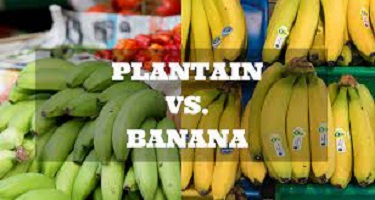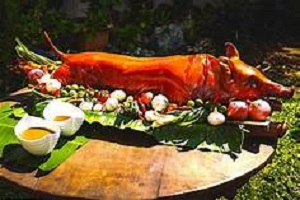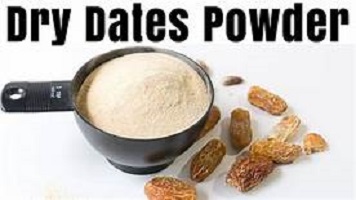Plantain Vs Banana: Difference Between Banana and Plantain
Plantain Vs Banana: The Difference Between Banana and Plantain

Difference between bananas and Plantains
Compared to bananas, plantains are bigger, have thicker skin, and contain more starch. Plantains are used in both sweet and savory recipes and can be eaten while ripe (yellow or brown skin) or unripe (green skin). In Latin American, African, and Caribbean cuisines, plantains are often prepared as vegetables.
What Is a Plantain?
A starchy tropical fruit belonging to the banana family is called a plantain.
Compared to bananas, plantains are bigger, have thicker skin, and contain more starch. Plantains are used in both sweet and savory recipes and can be eaten while ripe (yellow or brown skin) or unripe (green skin). In Latin American, African, and Caribbean cuisines, plantains are often prepared as vegetables.
What Is a banana?
A banana is a tropical fruit with soft, sweet flesh and an inedible yellow skin that is produced in bunches.
When they are still green, fresh bananas are plucked and are best stored at room temperature to ripen. Once peeled, ripe bananas can be eaten on their own or added to smoothies, desserts, or fruit salads. They have yellow skin with brown specks. Bananas that are damaged or overripe work best when baked into muffins or quick breads. The flavor of a banana is sweeter the riper it is.
Plantain Vs Banana
Let’s look at how they compare in terms of appearance, flavor, kitchen usage, nutrition, and storage.
You’ll have a fair idea of how these two long, finger-shaped fruits compare by the end of this page.
Is there a distinction between bananas and plantains?
Plantain Vs Banana Size
Plantain is a form of banana with a distinct flavor and culinary application. They are larger and have thicker skin than bananas. Plantains are also starchier and sugar-free than bananas. Depending on how ripe they are, they range in color from green to yellow to dark brown.
- Plantain Vs Banana Appearance
They appear to be very similar at first glance, which is unsurprising given that the plantain is a member of the banana family. Because the distinctions in their shape, skin, and flesh aren’t clear, you could be forgiven for mixing them up.
Plantains have thicker skin and are green in color.
There are a few differences between the two. A banana starts green, but as it ripens, it turns yellow. Plantains stay green until they’re fully ripe, then turn yellow or black when they’re overripe.
Plantains have thicker skin than bananas and grow for a longer period. In the correct growing conditions, a giant banana can grow to be around 12″ long, whereas a plantain can grow to be around 12″.
The white tint of the flesh inside each type of apple is remarkably similar. When you cut the plantain in half, you’ll notice higher starch content, similar to when you cut a potato in half.
- Plantain Vs Banana Taste
Do plantains have a banana taste? Plantains do not have a banana taste. Because plantains are a separate fruit that isn’t eaten raw like most bananas, they don’t have a “banana” flavor. Plantains are sweet like bananas when fully mature, but have a distinct flavor.
- Plantain Vs Banana – Texture and Flavor
Bananas have a tropical sweet flavor and perfume, and their soft texture allows them to be eaten raw as a snack.
Plantains have a high starch content, so they should be cooked before eating. The texture of an uncooked plantain is comparable to that of a green banana.
Once cooked, an unripe plantain will be crisp yet considerably softer than ripe plantain. The more time a plantain is allowed to mature, the more sugar it produces.
Plantains contain less sugar and more starch than bananas.
- Functions, Uses – Plantain Banana Benefits
Bananas can be eaten raw, used in smoothies, fruit salads, or cooked in sweets due to their soft texture and high sugar content. They also add a burst of sweetness to savory meals like Hawaiian chicken.
Plantains should be treated as starchy vegetables. The horn plantain and the French plantain are the two types of plantains that are supposed to share a common origin.
Both varieties grow in India, Africa, Egypt, and tropical America.
Plantains are an important part of the Caribbean, Indian, and African traditional diets. When using them in recipes, treat them as if they were vegetables like potatoes or butternut squash.
To minimize the starchy flavor and texture, peel, then bake, sauté, or roast. They’re great with ackee for a carb-heavy breakfast, as well as saltfish.
Weight control: Plantains are rich in a type of fiber that helps you feel fuller longer. This may help you control your weight if you’re overweight or obese
Caramelized and served with cinnamon and coconut for a sweet snack that is both simple and tasty.
Plantains should be dehydrated before being ground into a gluten-free, low-allergen flour.
- Nutrition:
“The nutritional profiles of bananas and plantains are similar, but because of their extra starch content, plantains have more calories and carbohydrates than bananas,” the expert notes.
“Both provide some stomach-pleasing fiber to aid in digestion, as well as potassium and vitamin B6, which support the immune system and brain function, respectively, and muscle function.”
Ripe vs. Unripe Plantains: Which is healthier, green or ripe plantains?
Both are fantastic. Yes, green/unripe plantains are better for a low glycemic load, however, due to the consistency and starchiness of the dish, they cannot be substituted in recipes.
You’ll need unripe or somewhat ripe plantains if you wish to make plantain chips, Boli, or Gizdodo. The softer plantains are preferable for traditional Nigerian plantain moi moi (ukpo ogede), plantain rolls, and plantain pancakes.
The black is excellent for creating bread since it can be mushy and mixed with flour to form a flatbread or fritter. You’ll be alright if you don’t eat too much.
- Plantain Vs Banana Nutritional Facts – Is it healthy to eat a banana or plantain?
Plantains have more carbohydrates than bananas, but bananas have more fiber.
Plantains have more calories per pound than bananas.
Both are low in fat and protein, but abundant in potassium, vitamin A, and vitamin C.
- Storage
Plantains take longer to ripen than bananas. Store it in a cool, dry location away from direct sunlight. Put them in the vegetable crisper if you want to speed up the ripening process.
It’s preferable to keep bananas separate from other fruits since the ethylene they release causes the other fruits to quickly ripen.
Plantains should be kept in a cold, dry area with other starchy vegetables like potatoes.
FAQs on Plantain Vs Banana
- Is it possible to substitute bananas for plantains?
In a savory side dish, bananas would not be a good substitution for plantains because their texture is considerably softer. If you’re making a sweet dessert, bananas can be used instead of apples.
- Do plantains contain the same amount of potassium as bananas?
Plantains have a higher potassium content than bananas. A banana contains 716mg of potassium, whereas a cup of plantains contains 930mg.
- Is it possible to eat a plantain raw?
Raw plantains will not make you sick, but green plantain’s flavor will be harsh, starchy, and unpleasant.
- How can I quickly ripen plantains or bananas?
Place a plantain or banana in a paper bag along with an apple or pear to ripen. Fold the bag’s opening a few times to close it, then set it on the counter. Check the fruit every day to see if it’s ready to eat.
- I’m looking for a place to buy plantains.
Fresh plantains can be found in supermarket produce sections, local markets, and Asian and African specialty grocers.
Summary of Plantain Vs Banana
On the supermarket shelf, plantains and bananas seem extremely similar. It’s understandable if an unwary shopper mixes the two.
Taste and texture are the most noticeable differences between these two fruits. Bananas are soft, delicious, and can be eaten right out of the hand. In the kitchen, plantains are more like vegetables and should be cooked in most cases for the best results.
Are bananas and plantains the same?
In reality, plantain is a kind of banana, but one with a distinct flavor and application in cooking. Similar to bananas, they originated in Southeast Asia but are now produced all over the world. They often have thicker skins and are bigger than bananas. Bananas are higher in sugar and less starchy than plantains.
Is Nigerian plantain a banana?
Though they are longer, have thicker skin, and contain more starch, plantains resemble bananas. Additionally, they are a significant staple meal in Asia, Latin America, and Africa. Unless they are quite ripe, they are often fried rather than eaten raw.
Can you eat a plantain like a banana?
Since it doesn’t peel or taste like a banana or can be eaten in a different way than a banana, I believe that most people are puzzled by its striking resemblance to a banana. Being a starchy relative of the banana, the plantain usually requires cooking before consumption due to its high starch content.
Is plantain another word for banana?
Although the term “plantain” refers primarily to any fruit that is cooked as opposed to raw, it can also refer to a particular weedy plant. Plantains are used in many different recipes, including soups, dumplings, chips, appetizers, and sweet drinks.
What’s the difference between green banana and plantain?
When they reach maturity, plantains are about 12 inches long and green or black, while bananas are about 6 inches long and yellow.
The primary morphological distinction between plantains and green bananas is that the former have short, rounded ends, while the latter have thin, elongated, seemingly sharp ends.
What is the plantain called locally?
Name in English: plantain. Jioko, oji-oko, aha igbo. Agade, ayaba in Hausa. Ogede in Yoruba.
Why can I eat plantains but not bananas?
The majority of people have allergies to dietary proteins, which change when heat is applied. Similar to potatoes, plantains are starchy and taste bad when eaten uncooked. As a result, you would only eat fried plantains rather than sweet bananas, which would reduce the possibility of allergic reactivity.
Is English plantain a banana?
The tropical plantains that resemble bananas are unrelated to this plantain and the other members of the plantain family. Those fruits belong to a different family and are more closely associated with cardamom and ginger. The English plantain is more closely related to lilacs and mints. Height: from 5 to 15 inches.
Are plantains just fried bananas?
Plantains belong to the same family as bananas. They are a low-sugar, starchy kind that is best served cooked; they are not good served fresh. It is widely used in savory meals, much like potatoes, and is particularly well-liked in the countries of the Caribbean and Western Africa. Usually, it’s baked or fried.
Difference between banana and plantain tree: plantain tree vs banana tree:
Description:
In general, the plantain tree’s leaves grow more erect and in clusters than those of the banana tree. These two plants have pseudostems that resemble a single trunk, but they are several different branches that sprout from the main plant.
Difference between banana and plantain taste
Flavor: Only ripe, sweet bananas should be consumed; the riper the banana, the sweeter it is. Ripe plantains (yellow or brown) have a pronounced sweet flavor, whereas unripe (green) plantains have a bland, starchy flavor. Texture: bananas have a creamy, soft texture, whereas unripe plantains are stiff and starchy.
Difference between banana and plantain fruit
Generally speaking, plantains have substantially thicker skin and are rougher and larger than bananas. They could be extremely dark brown, yellow, or green. When green, plantains are less sweet and starchier than bananas. They are sweeter when ripe and get even sweeter when cooked.
Difference between banana and plantain benefits
Plantains contain a lot of complex carbohydrates, just like bananas, but compared to bananas, the majority of the carbohydrates are derived from starch. Although plantains are high in nutrients, their overall health benefits are mostly dependent on how they are prepared.
Difference between banana and plantain and ripe plantain
Generally speaking, plantains have substantially thicker skin and are rougher and larger than bananas. They could be extremely dark brown, yellow, or green. When green, plantains are less sweet and starchier than bananas. They are sweeter when ripe and get even sweeter when cooked.
Is plantain a banana
A starchy tropical fruit belonging to the banana family is called a plantain. Compared to bananas, plantains are bigger, have thicker skin, and contain more starch. Plantains are used in both sweet and savory recipes and can be eaten while ripe (yellow or brown skin) or unripe (green skin).
Plantain vs banana nutrition
Bananas are richer in fiber and lower in carbs. There are a few extra calories in plantains. Carbohydrates are abundant in plantains. Potassium, vitamin A, and vitamin C are abundant in plantains.
Plantain vs banana calories
The primary distinction is that although plantains have more carbohydrates from starch, bananas contain more carbohydrates from sugars. Their caloric content is comparable, ranging from 89 to 122 calories per 100 grams. Neither is a substantial source of protein or fat
Health Benefits of Plantains
Plantains, which are closely related to bananas, offer several health benefits:
- Nutrient-rich: Plantains are a good source of complex carbohydrates, fiber, vitamins (such as vitamins A, C, and B6), and minerals (including potassium, magnesium, and iron).
- Digestive Health: The high fiber content in plantains promotes digestive health by preventing constipation and aiding regular bowel movements.
- Heart Health: The potassium found in plantains helps regulate blood pressure, reducing the risk of cardiovascular diseases like stroke and heart attack.
- Improved Vision: Plantains contain vitamin A, which is essential for maintaining healthy vision, especially at night.
- Boosted Immunity: Vitamin C in plantains supports the immune system, helping the body defend against infections and illnesses.
- Energy Boost: With their complex carbohydrates, plantains provide a steady release of energy, making them a good option for sustained energy levels.
- Weight Management: The fiber content in plantains contributes to a feeling of fullness, potentially aiding in weight management by reducing overeating.
- Reduced Anemia Risk: Plantains contain iron, which is crucial for preventing iron deficiency anemia.
- Anti-Inflammatory Properties: Some compounds in plantains possess anti-inflammatory properties, which may help reduce inflammation in the body and alleviate symptoms of inflammatory conditions.
- Skin Health: Vitamin A in plantains is beneficial for maintaining healthy skin, promoting cell turnover, and reducing the risk of skin disorders.
- Regulated Blood Sugar: Despite being sweet-tasting, plantains have a lower glycemic index compared to bananas, meaning they are less likely to cause spikes in blood sugar levels.
Adding plantains to a balanced diet can contribute to overall health and well-being. However, it’s essential to consume them in moderation as part of a diverse diet.
The Health Benefits of Bananas
Bananas are not just a convenient and delicious snack; they’re also packed with nutrients and offer numerous health benefits:
- Rich in Nutrients: Bananas are a good source of several essential vitamins and minerals, including potassium, vitamin C, vitamin B6, and manganese.
- High in Potassium: Potassium is essential for maintaining proper heart function and blood pressure levels. Bananas are particularly high in potassium, making them a heart-healthy food choice.
- Improved Digestive Health: Bananas contain dietary fiber, which helps regulate bowel movements and may alleviate constipation. They also contain prebiotics, which support the growth of beneficial bacteria in the gut.
- Energy Boost: Bananas are an excellent source of carbohydrates, which are the body’s primary source of energy. Eating a banana before or after exercise can help replenish glycogen stores and provide a quick energy boost.
- Heart Health: The potassium and fiber in bananas may help lower the risk of heart disease by reducing blood pressure and cholesterol levels.
- Weight Management: Despite their sweet taste, bananas are relatively low in calories and fat. They also contain dietary fiber, which can help you feel fuller for longer, potentially aiding in weight management.
- Improved Mood: Bananas contain tryptophan, an amino acid that the body converts into serotonin, a neurotransmitter that helps regulate mood and promote feelings of happiness and well-being.
- Natural antioxidants: Bananas contain a variety of antioxidants, such as catechins and dopamine, which help lower oxidative stress and shield cells from free radical damage.
- Supports Exercise Performance: Bananas are a popular choice among athletes because they provide a quick source of energy and replenish electrolytes lost through sweat, such as potassium.
- Blood Sugar Regulation: Despite their sweetness, bananas have a relatively low glycemic index (GI), which means they don’t cause a rapid spike in blood sugar levels. This makes them a suitable snack option for individuals with diabetes when consumed in moderation.
Incorporating bananas into your diet can contribute to overall health and well-being, but as with any food, moderation is key.



Pingback: Banana Peel Tea for Sleep – Benefits, Recipe, and Tips - 9jafoods